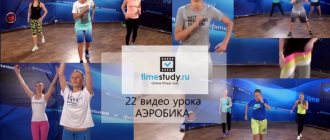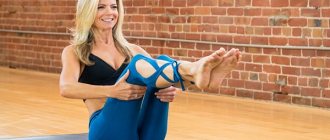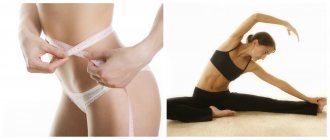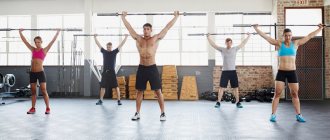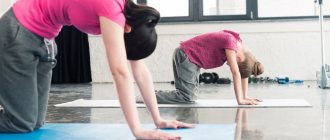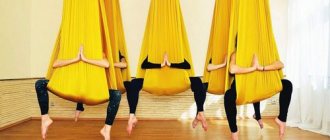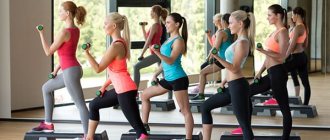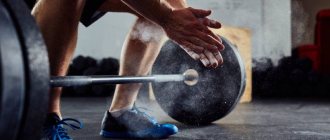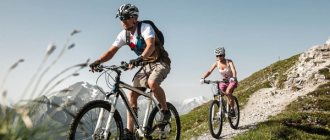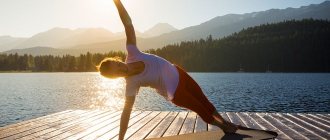Yoga is a popular activity that is accessible to people of any level of physical fitness at home. How to start doing yoga at home? What asanas are suitable for an unprepared person? How long to practice? These and other questions are asked by people who dream of understanding all the secrets of ancient art. To practice yoga correctly, it is best to take a course under the guidance of an experienced trainer, but you can try to learn the practice on your own.
It would seem that there is plenty of information, but this is precisely what is confusing: it is impossible to remember everything at once, and putting it all together is even more difficult. In this article, we tried to collect all the tips for beginners and answer the most popular questions.
Where to begin
- Start with theory - get to know the direction, its history and features. Start now, not next Monday. Pay special attention to the results that can be achieved, recommended nutrition, contraindications (see the benefits of yoga for health).
- After theoretical preparation, proceed to choosing a place for classes - perhaps this is one of the most important preparatory moments for home classes. It should be a quiet, cozy and always clean corner or a warm room without drafts, bright light, with a minimum of things and distracting objects. Comfort and warmth are extremely important: in a cold room, muscles and ligaments slowly warm up, which increases the risk of injury and sprains. If it is impossible to create perfect silence, buy earplugs.
- Prepare a clean mat made from natural fibers - bamboo, linen, or a special one for yoga. Also stock up on an eco-friendly blanket that you can throw over your shoulders during meditation. And lastly, prepare comfortable clothes that do not restrict movement.
- Immediately set aside a time for practice in which no one and nothing will distract you from practice, including pets, phones, ticking clocks, etc.
Make a schedule and stick to it: this is not only a matter of discipline, but also a guarantee that classes will take place at the same time. The first time you should spend 15-30 minutes doing yoga and increase it to 1-1.5 hours, taking into account that you practice daily. The second option is two-hour classes every 2-3 days.
Important! There is more than enough information about yoga that allows you to start practicing at home on your own. But we advise you to start studying with a professional and attend at least a couple of classes. A specialist will help you choose the right asanas or adjust the exercises you like to suit the person’s level, health status, age and gender.
Lesson 4. Yoga in the office
If you sit at a desk or at a computer all day at work, and you don’t have the opportunity to stretch and walk, then this simple set of exercises will help you:
- relieve fatigue;
- improve concentration;
- cheer up and recharge with energy.
When you work at a computer or at a desk with documents, all your attention goes into the subject of the work. Attention leaves the body and it becomes numb, you don’t feel it. The neck, shoulder and working arm (usually the right) are especially affected. Sometimes there is a curvature of the spine.
You can work on your body without leaving your desk:
— activate special energy points;
- work out the spine: cervical, thoracic and lumbar;
— stretch the stiff muscles of the neck and shoulders.
Thus, by devoting just a few minutes to your body, you will again feel invigorated and full of energy. Practice this complex or individual exercises from it several times during the working day, and you will go home quite invigorated, and not squeezed like a lemon.
This complex is also good to use on the road if you have to spend a lot of time on an airplane or driving.
Breath
A whole direction is devoted to breathing - pranayama. For amateurs, it is enough to master the basic principles of breathing, without which the exercises will not be as effective.
- Learning to “breathe with your belly.” This is what diaphragmatic breathing is called: while inhaling, we inflate the stomach, while the chest remains motionless, and as we exhale, we draw in the stomach. It is difficult to accustom yourself to this type of breathing (we all mostly “breathe” through the chest), but this is how you can increase the working capacity of your lungs, reduce the incidence of respiratory diseases and get the maximum benefit from yoga.
- Breathe slowly and deeply. This is the basis for relaxing the body and subsequent “gaining” energy.
- We stick to the rhythm. The basic rules for dynamic exercises are as follows: movements in which you need to stretch your arms, body, and head upward) are performed while inhaling, and positions directed downward are performed while exhaling. But even in static poses, breathing plays a significant role - each exhalation will help you relax more and correctly enter the position.
- It is very important not to hold your breath. This also comes with time.
Lesson 7. Relaxation yoga course. Lesson 1
Stress is the scourge of our time. Have you ever thought that stress can be viewed not as a problem, but as an opportunity for personal development?
In a series of video lessons, which we called “Relaxation Yoga Course,” Vitaly Lyalin says:
- how you can benefit from stress;
— how to work with stress so that it does not cause illness or disease;
- how to learn to relax.
In the first lesson, we learn to relieve tension caused by prolonged sitting at a computer or working in an office - we work on the neck, shoulders and chest area.
Warm-up: proper body preparation
Before classes, it is very important to warm up the muscles and ligaments - this will reduce the risk of injury and make the poses effective and painless. If muscles and ligaments are not prepared, they will relax for a longer time, and with high loads, muscle and connective tissue may be torn.
There are three types of warm-up:
- Passive. Warming up the muscles in a sauna, hot tub, shower.
- General. Active physical movements, for example, walking, running, cycling.
- Special. Yoga exercises.
To warm up at home, you can use running in place. A special warm-up includes performing dynamic asanas, for example, poses from the sun salutation cycle. This is a complex of 12 poses that perfectly warms up the muscles and ligaments and prepares them for stretching. It is performed slowly, smoothly, calmly, i.e. does not exert any load. It is based on both movements and breathing techniques: bending is performed while exhaling, and bending backwards while inhaling. You need to breathe through your nose.
Starting position: stand on a hard floor, feet together, back straight, eyes looking straight. Distribute your body weight evenly on both feet.
|
|
|
|
|
|
|
|
After this position, you need to return to the previous poses: rider, forward bend, solar, greeting. You can perform all 12 asanas, or you can choose 2-3 and perform as many of them as the body requires for preparation.
Knee to head
A simple movement will help add dynamics to the previous exercise.
- You should stand in cat pose and, as you exhale, with your back rounded, pull one leg as close to your forehead as possible.
Push all the air out of your lungs and tense your abdominal muscles
- As we inhale, when we arch our back, we move our leg back
P
Such a simple manipulation will increase the range of motion, therefore stretching the back and working the abdominal muscles will be greater. In addition, this exercise forces the gluteal muscles to work.
Which yoga is better to start with: asanas from which you can create a universal complex
Hatha yoga is considered a universal direction: a modern teaching that is widespread in many countries and adapted for the student of the 21st century. But many people simply choose certain asanas for themselves, bring them to perfection and find harmony and health in them.
We present to your attention several simple asanas that are suitable for starting to get acquainted with yoga and do not require special stretching or physical training.
Vrksasana or tree poseStand up straight, inhale and slowly raise your arms up to your sides and bring your palms together so that your fingers point up. Try to gently move your arms back, as if straightening and opening your chest. Bend your right leg at the knee, rest your foot on the inner part of your left thigh, toes down, as high as possible. Stay in the position as long as you can, but make sure the pose does not cause discomfort. Slowly return to the starting position. Repeat the same pose for the other leg. |
Utthita Trikonasana or Extended Triangle PoseStand up straight, take a deep breath, and while jumping, spread your legs 1 meter apart so that your feet are parallel to each other. Stretch your arms out to the sides at shoulder height so that your palms face down. Turn your right foot 90 degrees so that your toe points to the side, leave your left leg in its original position so that your toe points forward. As you exit, tilt your torso to the right so that your right palm touches the floor behind your right leg. At the first stages it will be difficult; you can put your palm on your ankle. Stretch your left arm up so that it is perpendicular to the floor. Stay in this position for 30-60 seconds, breathe freely. As you inhale, return your body to the reverse position and turn your feet forward. Repeat the asana on the other side. |
Balasana or child's poseGet on your knees, lower your pelvis onto your heels, take a deep breath and tilt your body forward, pressing your chest and head to the front of your thighs. The forehead should touch the floor. It is important to keep your back straight. Stretch your arms back so that your palms face up. Breathe calmly, at the same pace, feeling the movements of your chest. To exit the asana, smoothly lift your head off the floor and then lift your torso. |
Adho Mukha Svanasana or slide poseGet on all fours, turn your palms with your fingers forward, leave your knees, feet and hands shoulder-width apart. Focus on your palms and push your pelvis back and up to form an impromptu slide. The back should continue the line of the arms, the head should also be in a straight line with the back. The heels should touch the floor tightly; it is not advisable to bend the knees. Stretch your chest toward your knees, with your tailbone pointing toward the ceiling. Try not to pull your stomach in; your abdominal muscles should be relaxed. |
Utkatasana or chair poseStand straight and spread your feet shoulder-width apart, stretch your arms straight up to your sides so that your palms face each other. Slowly bend your knees, move your pelvis back so that your body leans slightly forward. The pose should be as if you were sitting on a chair. The knees should not protrude beyond the level of the toes, the arms remain extended upward and form an even line with the back and head. Stay in the pose for as long as you can, slowly come out of the asana. |
Sarvangasana or candle poseLie on your back, stretch your arms along your body, lift your straight legs up, pull your pelvis behind your legs, helping yourself with your palms. After your pelvis and legs are raised up and stretched towards the ceiling, place your palms as close to your shoulder blades as possible. Hold the position for 10 seconds, increasing the time with each session. Exit the position smoothly and slowly. |
Arlha Matsienlrasana or King of Pisces PoseSit on the floor, stretch your legs forward, straighten your back and shoulders. Bend your right leg at the knee joint and place it behind your left. The left leg should also be bent at the knee, and the heel should be brought as close as possible to the body (buttock), try to lower the knee lower. Initially, you can leave your left leg extended and bend only your right leg. The next action is to grab your right knee with the palm of your left hand and twist your body to the right. As you exhale, slowly twist. Then bend your left arm at the elbow and place it behind your right knee, holding the twisted position. Try to twist even more during each subsequent inhalation, hold in the extreme position for a while, return to the starting position and repeat the same on the other side. |
Eka pada rajkapotasana or pigeon poseGet on all fours, pull your right leg, bent at the knee, towards your chest, turn your foot to the left and lower your leg to the floor: the heel should be under your left thigh. Extend your left leg back and lower your pelvis as far as possible. Leaning on your forearms, tilt your body down as much as possible, trying to stretch your left leg even further back. Repeat the same for the other leg. A good pose for stretching, allowing you to do the splits later. |
Shavsana or Dead Pose (Corpse Pose)Lie on the floor, close your eyes, stretch your arms along your body. Tighten all your muscles as much as possible for a few seconds, then relax as much as possible, focusing on your breathing. Stay in this state for 4-5 minutes. The pose is good for relaxation between other poses and as a finishing asana. |
You can use all the asanas or choose those that are easiest to master.
Precautionary measures
Yoga helps restore health, but for some diseases it is contraindicated. You can start exercising only with the permission of a doctor and under the supervision of an experienced trainer.
It is forbidden to perform asanas for people who have:
- oncological diseases;
- chronic renal and liver failure;
- diseases of the cardiovascular system;
- traumatic brain injury, spinal injury
- gastrointestinal diseases during exacerbation.
You can do yoga during pregnancy, but you need to carefully monitor your condition. If a woman has already practiced yoga before pregnancy, performing asanas should not cause any particular difficulties. But for a beginner, it is better to choose simple asanas for relaxation, and restore the figure after the end of the postnatal period.
Which asanas are best for men, women, pregnant women, the elderly, children
Yoga is a unique direction that takes into account the characteristics of the female and male body, as well as the condition of people at a certain age. Which poses are most suitable for different categories and people? Is it possible to start doing yoga at 50? The answers are below.
- Pregnant women, in the absence of contraindications and after agreement with the gynecologist managing the pregnancy, can perform the following poses: warrior, pigeon, triangle, crescent, cat-cow, tied knot. The safest trend is considered to be the modern one - aqua yoga. Inverted poses are contraindicated, as are exercises that require straining the lower back and abdominal muscles.
- For men, the positions of lotus, bow, cobra, locust, mountain, tree, bridge are recommended. The most effective asanas for potency: plow, bow, cobra pose.
- older people to start practicing with a trainer. The following poses are suitable for regular practice: lotus, cat, dog facing down and up, king of fish, corpse.
Yoga for children
Yoga for children is not so popular: more often kids become followers of their “advanced” parents, who cannot imagine life without practice. Meanwhile, this is an excellent option for developing flexibility and coordination, developing healthy and beautiful posture, and strengthening the immune system. Yoga is more popular with introverted children, but for parents of restless, hyperactive children, the practice can be a real salvation - it will teach children perseverance, emotional balance and calmness.
The optimal age for learning yoga is 7-8 years old. Classes must be conducted under the guidance of an experienced teacher. There are also groups for children from 4 years old, but they are more like a fun game and do not require exact repetition of asanas.
The exercises are based on postures for adults, but are made easier - difficult and traumatic positions are excluded.
Lesson 10. One-hour yoga and meditation lesson for beginners in Sarva
To truly immerse yourself in the practice and fully experience the effect of yoga, you need to devote at least an hour to this activity.
We offer you an hour-long yoga and meditation lesson filmed in. The center was built in a secluded place, in nature, not far from a deep karst lake that does not freeze in winter - a natural source of strength. This center was built specifically for practice, and many famous Masters come here to give master classes, seminars and retreats. The atmosphere of this magical place, filled with peace, is well conveyed during the lesson.
Take an hour of time to do this special activity, observe yourself and compare how you feel before and after practice.
Useful tips
- You can take a shower before exercise, but it is not recommended after - long-term changes in blood circulation after exercise should gradually return to normal work.
- The room must be ventilated before classes, but during practice the windows must be closed;
- Start your workout refreshed but in a relaxed state. If you are tired or something is gnawing at you, it is better to rest for a while or reschedule the lesson.
- You can’t exercise on a full stomach - you can do it on an empty stomach or 2-4 hours after eating. You can drink some water, natural juice, green tea or warm milk. You can also drink some water between exercises.
- Remember to breathe continuously and evenly.
- When performing asanas, at first you should not try to achieve the ideal position through pain; it is better to perform them with incomplete amplitude, persistently and patiently achieving the correct position.
- Between asanas, relax as much as possible the muscles that contract during exercise. A minute's rest is enough.
- Perform asanas in three stages: entry, stay in the pose and exit to the starting position.
- Stay in the main position of the exercise for as long as possible, without moving. In the extreme version of the asana, there is acceptable discomfort.
- You need to enter and exit the position very smoothly and slowly.
- Each asana should be repeated 4-6 times. If you already easily enter poses and hold the desired position without problems, the number of repetitions can be reduced.
- If you feel anxiety or discomfort while in a pose, you should immediately end the exercise.
- Make sure your movements are smooth. Learn to balance smoothly and not sway in different directions.
- Make the classes more difficult gradually. Start with asanas that you can actually master. With each session, perform the exercises deeper and stay in the position longer. Performing inverted asanas is the prerogative of experienced yogis. These exercises should not be used by beginners.
- If possible, the lesson should last one hour or more. Typically, a set of exercises lasts from 1.5 to 2 hours.
- If it happens that you need to finish the workout earlier, shorten it not by increasing the speed of performing asanas, but simply reduce the number of poses.
- If on the day of training you do not feel very well, you have a fever or malaise, there was active physical activity the day before, severe stress, or drinking alcohol - postpone the training.
- Concentrate on what you are doing and don't be in the clouds. Concentration is the basis of yoga.
If you did everything correctly, after the lesson you should feel maximum relaxation, both in your thoughts and in your body, lightness and well-being. Immediately after classes you cannot begin vigorous activity or physical labor.
Is it possible to lose weight by doing yoga?
This practice is not the best method for losing weight, especially for those who crave quick and significant results. Gradual improvement of metabolic processes, coupled with proper nutrition, allows you to lose extra pounds, but this requires months of practice.
Lesson 1. Joint stretching. While the body is flexible, it is young
Before you begin complex yoga asanas, such as splits or lotus, you need to carefully work out your joints. After this, muscle stretching will be much easier.
In addition, a flexible body means youth, health, beauty, an inner feeling of lightness and freedom.
This short complex can be performed both as a warm-up before the main practice, and as an independent exercise.
It is best to perform it in the evening, when the body is more flexible and responds more easily to this type of load.
Don’t be upset if you can’t do some asanas, for example, if you couldn’t sit in the half lotus. For most people, even young people, this does not happen right away. Working on the hip joints takes time and patience. Practice to the best of your ability, have fun, and over time everything will work out.
Why do you feel bad after practice?
It also happens that instead of the promised total relaxation and surge of vitality, a person feels bad. There are several reasons why this is so. The most common:
- classes are held in a stuffy room without ventilation;
- asanas are performed incorrectly;
- the person does not monitor breathing;
- asanas are performed in a hurry, without warming up the muscles;
- the trainer is not a professional;
- classes are held irregularly;
- contraindications are not taken into account, etc.
Instead of an afterword
Yoga can and should be considered as an effective direction for healing and achieving internal and external harmony. To find out if it's right for you, you need to try it. This is much more effective and easier than watching pictures and videos for a long time. But you need to try yoga from scratch with an experienced trainer, preferably through personal training: general classes are effective for practitioners.
Sun salutation, warm-up routine
Complex for beginners
Complex for beginners
Hatha for Beginners
Yoga for the elderly
Yoga for Beginners
Types of poses
There are different poses in yoga. They are divided into several types, each of which determines a specific effect. Exercises fall into five main categories.
standing
Most often performed at the beginning of a lesson as a warm-up. Asanas performed from a standing position are the most difficult for beginners. Hatha yoga practices these asanas separately and involves rest between them, and Vyansa flow - a cycle when they follow one after another, which helps build ligaments.
To develop balance
This category of exercises is considered the most important and useful for beginning practitioners. It helps you develop balance and strengthen your core muscles. This is extremely important for further training and performing complex poses. Maintaining balance in the first lessons will be quite difficult, but after some time the improvements will become noticeable.
Bridges
Some of the most uncomfortable asanas for most beginners. Such poses should be mastered with light bending and stretching of the spine. In everyday life, such movements are performed extremely rarely, which is the cause of numerous problems with the musculoskeletal system. This makes these poses simply necessary to maintain the spine in good and healthy condition.
In a sitting position
Seated exercises focus on stretching the hamstrings and hips. These poses are usually done at the final stage of training, since the body is maximally warmed up and the muscles are ready for such a load. To increase the comfort of the pose, it is recommended to use a block or a folded regular blanket, which is placed under the buttocks.
For relaxation and on the back
These asanas allow you to rest between individual movements. Child's pose provides a particularly good respite. Techniques that are performed in a lying position are aimed at stretching tendons and muscles, and also help with twisting and bending.
Yoga for beginners. Olga Borodina
